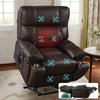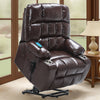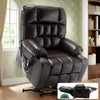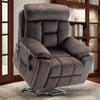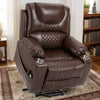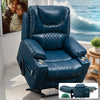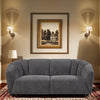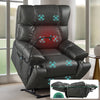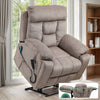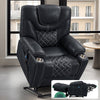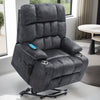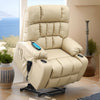Understanding the Needs of Elderly Comfort Seekers
Assessing the Physical Challenges and Comfort Requirements
As we age, our bodies face unique challenges. Seniors often deal with joint pain, muscle weakness, and reduced mobility. These issues make sitting and standing difficult. Comfort becomes crucial for their well-being.

Elderly individuals need furniture that supports their body properly. They require seats that don't strain their backs or joints. Easy entry and exit are also vital. Many seniors struggle with traditional chairs due to these needs.
Proper support can prevent further health issues. It can also improve overall quality of life. That's why choosing the right seating is so important for older adults.
The Role of Ergonomics in Furniture for the Elderly
Ergonomics plays a key role in designing furniture for seniors. It focuses on creating items that fit the user's needs. For the elderly, this means chairs that support good posture and reduce pain.
Ergonomic furniture considers factors like seat height, depth, and back support. It aims to distribute weight evenly and minimize pressure points. This can help prevent discomfort and potential injuries.
Good ergonomics can also promote better blood flow and reduce muscle strain. It allows seniors to sit comfortably for longer periods. This is especially important for those with limited mobility.
The Benefits of Lift Chairs Over Traditional Recliners for Seniors
Ease of Access and Lift Assistance
Lift chairs offer a significant advantage over traditional recliners for seniors. They provide motorized lifting mechanisms. These help users stand up or sit down with ease.

This feature is invaluable for those with mobility issues. It reduces the strain on joints and muscles. Seniors can maintain their independence longer with this assistance.
Traditional recliners, while comfortable, lack this crucial feature. They often require more effort to get in and out of. This can be challenging or even risky for some older adults.
Lift chairs promote safety by reducing fall risks. They offer a smooth, controlled motion. This gives seniors more confidence in their daily activities.
Enhanced Comfort and Support Features
Lift chairs go beyond basic reclining functions. They often include advanced comfort features. These can greatly benefit seniors with various health conditions.
Many lift chairs offer multiple position settings. Users can adjust to find their perfect comfort level. Some models even provide zero-gravity positions. These can help relieve pressure on the spine and joints.
Advanced models may include heat and massage options. These features can help soothe aching muscles and improve circulation. Memory foam cushions are also common. They provide excellent support and pressure relief.
Traditional recliners typically offer fewer customization options. They may not provide the same level of tailored comfort for seniors' specific needs.
Longevity and Maintenance Considerations
When it comes to durability, lift chairs often have an edge over traditional recliners. They're built to withstand frequent use of the lifting mechanism. This means they're designed for long-term reliability.
Many lift chairs come with warranties covering both the frame and the motor. This can provide peace of mind for seniors and their families. It also reflects the manufacturers' confidence in their products.
Maintenance for lift chairs is generally straightforward. Regular cleaning and occasional checks of the mechanism are usually sufficient. Some models even have removable covers for easy washing.
Traditional recliners may require more frequent replacement of worn parts. Their simpler construction can sometimes lead to quicker wear and tear.
Incorporating Lift Chairs into Home and Assisted Living Facilities
Design Principles for Selecting the Right Lift Chairs
Choosing the right lift chair involves several key design principles. First, consider the size and scale of the chair. It should fit the user's body type and the available space in the room.

Look for chairs with sturdy construction and high-quality materials. These ensure safety and longevity. The upholstery should be durable and easy to clean. This is especially important in care facilities.
The control system should be simple and intuitive. Large, clearly marked buttons are ideal for seniors. Some chairs offer remote controls with limited options to prevent confusion.
Consider the range of positions the chair offers. It should meet the specific needs of the user. For example, some may need a full recline, while others just need a slight lift.
How Lift Chairs Improve Quality of Life for Elderly Residents
Lift chairs can significantly enhance the daily lives of elderly residents. They promote independence by making it easier to sit and stand. This can boost confidence and reduce reliance on caregivers.
These chairs often become a comfortable spot for various activities. Residents can read, watch TV, or socialize without discomfort. The ability to change positions easily helps prevent stiffness and soreness.
For those with conditions like arthritis or back pain, lift chairs provide much-needed relief. The gentle lifting motion reduces strain on joints and muscles. This can lead to less pain and better mobility.
Lift chairs can also improve sleep quality for those who have trouble lying flat. The ability to sleep at an incline can help with issues like acid reflux or breathing problems.
Case Studies: Successful Lift Chair Implementations in the United States
Several retirement communities across the U.S. have seen positive results from introducing lift chairs. In a Florida facility, residents reported a 30% decrease in fall incidents after lift chairs were installed.
A nursing home in Ohio found that lift chairs reduced caregiver strain by 25%. Staff members experienced fewer back injuries related to assisting residents with sitting and standing.
In a California assisted living center, 85% of residents using lift chairs reported improved comfort. Many noted better sleep and less daily pain. This led to increased participation in social activities.
A study in a Texas memory care unit showed interesting results. Residents with dementia seemed more calm and content when using lift chairs. Staff observed fewer instances of agitation during seated activities.








